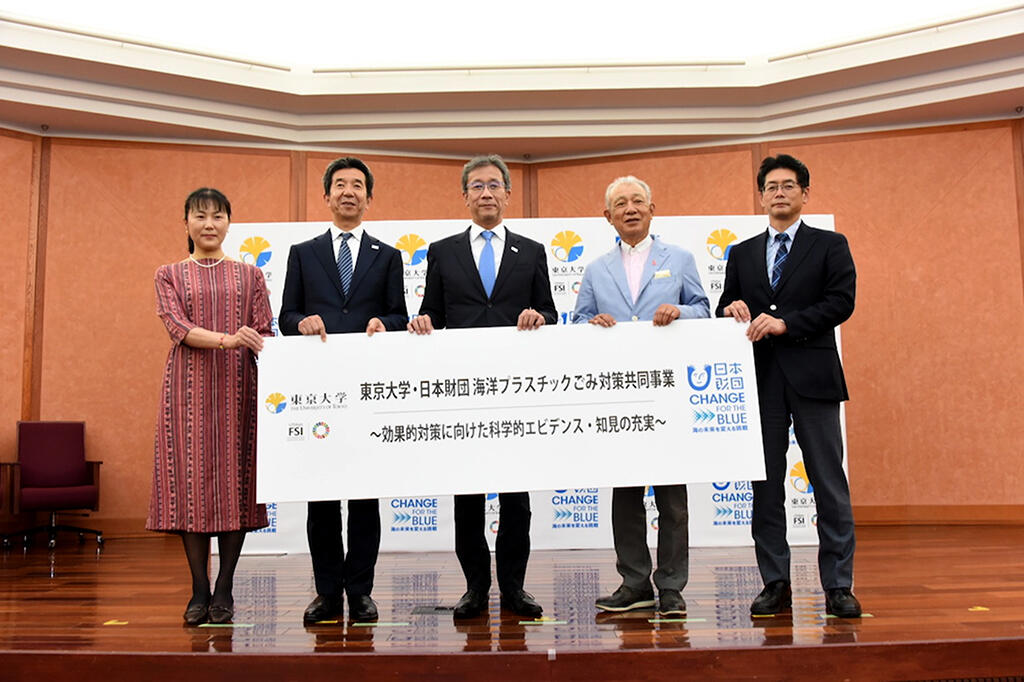
The University of Tokyo (President: Teruo Fujii) and the Nippon Foundation (Chairman: Yohei Sasakawa) announced on April 19 the outcome of their joint project, the Ocean Debris Project, at the Ito International Research Center of the University of Tokyo (Hongo, Bunkyo-Ku, Tokyo). They also announced that the two organizations had decided to implement a Phase Two, which is scheduled to last for the next three years. The two parties will make a deeper analysis on the research they have made so far and will aim for the social implementation of measures in model fields such as the Seto Inland Sea, to make policy recommendations based on scientific evidence, and realize the enactment of bylaws. The Nippon Foundation will contribute about 320 million yen to the project.
In his speech, Dr. Fujii said, "Looking at the results of the past three years, there are many new issues that have emerged and many things that are still unknown. We would like to further deepen and expand our scientific knowledge in the future. I believe it quite important to steadily establish scientific findings through research, in order to consider what we should do in the future."
The project has been operated by both parties since 2019 using a fund of about 350 million yen contributed by the Nippon Foundation. A team of more than 50 members was organized, including researchers from the University of Tokyo, Kyoto University and Tokyo University of Agriculture and Technology, and the research has been implemented for three years, in order to accumulate a scientific basis for addressing ocean plastic waste, disseminate precise information to society, create momentum to solve the issue, and reflect the research on policymaking.
More precisely, the research followed three themes: understanding the current status of ocean microplastics, evaluating the biological impacts of microplastics, clarifying the flow of and considering measures to reduce/control plastic wastes. As part of measures, action/research platforms have been constructed. As a result, 23 papers with a peer review and nine papers without one have been posted during the three years.
In order to understand the actual situation, a research voyage was made in August 2000, and investigation results revealed that after ocean microplastics were miniaturized smaller particles were selectively deposited on the seabed. A combination of findings obtained from collected microplastics on-site and the ocean simulations made it possible to make estimations on how miniaturized plastics behave. In addition, an analysis of 7,000 samples of sea water that were taken and stored by the Japan Fisheries Research and Education Agency for the past 70 years also made it clear that, during the 50s to 70s, the volume of ocean plastic waste increased at a rate of 10 times a decade, and that pollution was increasing. Besides the size of particles, it became apparent that how plastics are transported and how they are aged and deteriorated vary depending on the types of plastics.
In order to investigate the biological effect of ocean drifting plastic waste, the research team made a study of the accumulation of plastic-related chemical substances (including fire retardants added when the plastics were produced and other chemical substances attached on the surface of drifted plastics) in the body of terrestrial hermit crabs living in contaminated and noncontaminated seashores of Zamami Island and Iriomote Island in Okinawa Prefecture, where it was assumed that there were few pollution sources other than plastics. As a result, it was found that the terrestrial hermit crabs living in the latter areas accumulated more waste, and that the fire retardant had accumulated in their bodies after having transformed into highly toxic substances due to the metabolism in their bodies taking bromine out from the retardant. The above result was reproduced in a laboratory, too. The research made it clear that amount of time that miniaturized plastics remain in living bodies varies depending on size. The research team will investigate other elements such as gene response due to accumulation of plastics. An experiment using cultivated human cells has shown that miniaturized plastics with a particle size of several tens of nanometers in diameter were taken in by the blood flow while those of several hundred nanometers in by the lymph system. When plastics are taken into a living body, they are taken in by cells from the immune system for activation without being decomposed, meaning they do not induce an acquired immune response through antigen presentation. Research on the possibility of inflammations due to long-time exposure of plastics in living bodies will continue, according to the research team.
As to clarifying the flow of and considering measures to reduce/control plastic wastes, the research team presented that it was possible to make plastics visible for individuals and classify plastics into those that one can avoid using regularly and those they cannot, using the 'PLIDE (Plastic IDEntification) Chart' developed by Kyoto University, as well as appropriate treatment methods. At the same time, practical methods that could change the recognition and behavior of the general public were indicated by the research team by organizing roles and limits of international frameworks, governments and the industrial sector. Social issues to be solved for reducing use of plastics in the future were also presented.
This article has been translated by JST with permission from The Science News Ltd.(https://sci-news.co.jp/). Unauthorized reproduction of the article and photographs is prohibited.




